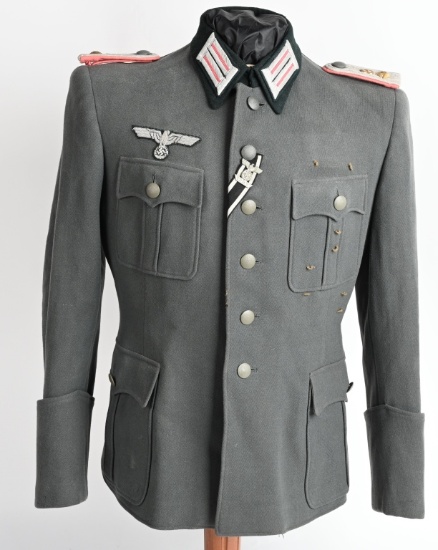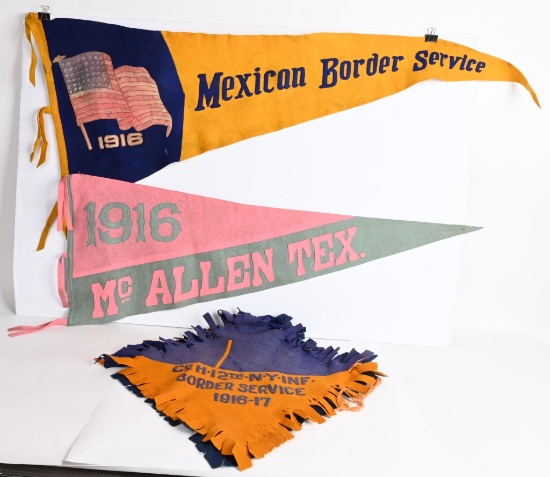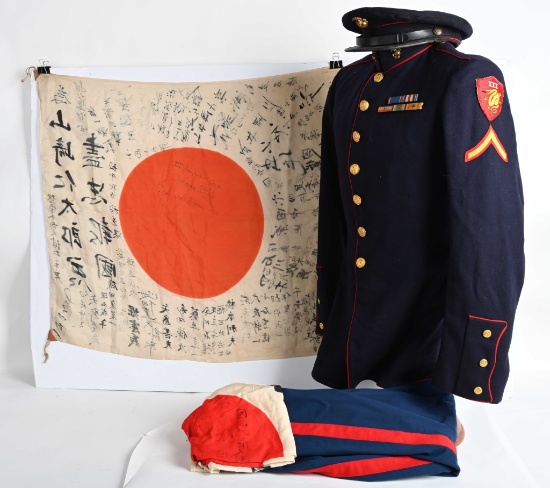
PREMIER MILITARIA & EDGED WEAPONS AUCTION

PREMIER MILITARIA & EDGED WEAPONS AUCTION
See Special Terms for additional fees
Cash Payment Discount: 3%
Description
PROUDLY PRESENTS
PREMIER MILITARIA & EDGED WEAPON AUCTION
OVER 700 LOTS OF MILITARIA FROM THE 18TH TO THE 20TH CENTURY. MORE THAN 25 LOTS of CIVIL WAR INCLUDING SWORDS, ACCOUNTREMENTS, IMAGES and MORE, INCLUDING AN IDENTIFIED CONFEDERATE POW'S SHELL JACKET;
WW1 and WW2 US GROUPINGS, EDGED WEAPONS, HELMETS, MEDALS, FLAGS, UNIFORMS, INSIGNIA, PATRIOTIC POSTERS and MORE INCLUDING MERRILL'S MARAUDERS GROUPING, NAMED MEDAL GROUPINGS, PAINTED COMBAT HELMETS, AND MORE. 30 PLUS LOTS of IMPERIAL GERMAN SWORDS, HEAD GEAR, MEDALS and MORE. 400 PLUS LOTS of WW2 NAZI GERMAN ITEMS INCLUDING a TRANSITIONAL WAFFEN SS HELMET, NAZI GERMAN ORG. TODT UNIFORM, NAZI GERMAN DIPLOMAT DAGGER, BADGES, MEDALS, INSIGNIA, HELMETS, UNIFORMS, SWORDS, BAYONETS, ACCOUTREMENTS, NSDAP PARTY UNIFORMS and MUCH MUCH MORE! JAPANESE ITEMS INCLUDING A PARATROOPER PARACHUTE, JAPANESE KATANA SWORDS, TANTOS, FLAGS, MEDALS, BADGES and MORE. KOREAN AND VIETNAM WAR LOTS, INERT ORDNANCE COLLECTION INCLUDING AN E1R1 FLAMETHROWER, INERT RPG, INERT MORTARS, INERT... Show more Show Less
Cash Payment Discount: 3%
Participation Requirements: Valid Credit Card required for bidding approval
Payment Options: Visa, MasterCard, Discover, American Express, Check, Money Order, and Wire Transfer
Visa MasterCard Discover American Express
Payment Instructions: SALES TAX All buyers will pay applicable state sales tax. Sales tax is require if mandated by the state you reside in for all internet sales and will be added to your invoice. If buyer provides a current state exemption form there will be no sales tax added. PAYMENT All merchandise must be paid in full within ten (10) days of the date of the sale. Purchases totaling $20,000 or more must be paid within three (3) days of the date of the sale. Call 440-527-8060 to pay your invoice by phone or mail payment to: 38198 Willoughby Parkway, Willoughby Ohio, 44094. Absentee bids placed through www.milestoneauctions.com and Proxibid.com will be auto charged to the credit card entered 48 hours after the end of the sale. If you wish to pay by another method please contact us within 48 hours after the sale. We accept Visa, MasterCard, Discover, personal checks/ certified checks, wire transfer, money orders, and cash. CREDIT CARD - For first time buyers and credit card charges greater than $2,500.00 buyers must complete the bottom portion of the invoice and must specifically sign the acknowledgement of our terms of sale before we will accept payment via credit card. We do offer the convenience of paying automatically by credit card. If you wish have your card automatically charged for all purchases please complete our Authorization for Automatic Credit Card Use. We have this form available upon request. Split payments are subject to a 23% buyer premium if a credit card is used as any form of total payment. CHECK - There will be a $30.00 service charge for returned checks. Make checks payable to: Milestone Auctions LLC. Milestone Auctions reserves the right to hold items paid for by personal or company check until said check clears (14 days). Milestone Auctions has the right to hold all checks over $2,000.00. Customers who have an established successful buying In the few situations where a successful bidder does not remit payment when due, Milestone Auctions will proceed with the legal steps necessary to protect its interests and will block the bidder from future auction participation.
Currency Type: USD
Shipping Instructions: Please see our terms and conditions.
Preview Date & Times: Items are available for preview 7 days prior to the sale by appointment. Auction day preview is February 13th at 8AM.
Checkout Date & Times: Please contact the auction company for checkout dates & times.
Location: 38198 Willoughby Parkway, Willoughby, OH 44094
Driving Directions:

By clicking "Confirm Buy" you are agreeing to the terms of the sale. Instant Purchase items may have additional fees such as an Internet Premium, Sales Tax, Shipping or other fees not included in the Instant Purchase price. Please see Auction Information for full details.
Payment Type:
HARRIS LIGHT CAVALRY 1899 GENERAL CUSTER BADGE
Lot # 45 (Sale Order: 51 of 784)
1901 MEMORIAM BLACK RIBBON WILLIAM McKINLEY AKRON
Lot # 46 (Sale Order: 52 of 784)
WW1 IMPERIAL GERMAN J.R. 53 PRUSSIAN SPIKE HELMET
Lot # 47 (Sale Order: 53 of 784)
IMPERIAL GERMAN PRUSSIAN GUARD FUSILIER REGIMENT
Lot # 48 (Sale Order: 54 of 784)
WW1 IMPERIAL GERMAN 2nd CLASS IRON CROSS LOT WWI
Lot # 49 (Sale Order: 55 of 784)
WW1 IMPERIAL GERMAN FIGHTING KNIFE BY EICKHORN WWI
Lot # 50 (Sale Order: 56 of 784)
IMPERIAL GERMAN 5 PLAVE MEDAL BAR OF BAVARIA EKII
Lot # 51 (Sale Order: 57 of 784)
WW1 PILOT WINGS AND RING MADE FROM REAL WINGS WWI
Lot # 52 (Sale Order: 58 of 784)
WW1 US ARMY US MEDICAL OFFICERS BELT BY MILLS 1917
Lot # 53 (Sale Order: 59 of 784)
WWI US ARMY 2ND DIVISION PATCH 9TH INFANTRY REGT
Lot # 54 (Sale Order: 60 of 784)
WWI IMPERIAL GERMAN SUBMARINE BADGE JUNCKER WW1
Lot # 56 (Sale Order: 61 of 784)
WW1 US TRENCH ART VASE LOT St. MIHIEL ARGONNE WWI
Lot # 57 (Sale Order: 62 of 784)
EARLY STATE OF MAINE NAVAL NATIONAL GUARD GROUPING
Lot # 58 (Sale Order: 63 of 784)
1920's 1930's LEATHER FLIGHT HELMET LOT OF 4
Lot # 59 (Sale Order: 64 of 784)
US MEXICAN BORDER SERVICE PENNANT LOT PILLOW SHAM
Lot # 60 (Sale Order: 65 of 784)
WW1 IMPERIAL GERMAN P08 LUGER HOLSTER 1915 DATED
Lot # 60a (Sale Order: 66 of 784)
WWI GERMAN SENIOR FORESTRY CUTLASS W/ SIDE KNIFE
Lot # 61 (Sale Order: 67 of 784)
WW1 GERMAN PRUSSIAN EM/NCO'S M1915 PICKELHAUBE WWI
Lot # 62 (Sale Order: 69 of 784)
WWI ORIGINAL GERMAN LEATHER CHINSTRAP LOT OF 2 WW1
Lot # 62a (Sale Order: 68 of 784)
WW1 US AIR SERVICE FLIGHT INSTRUCTOR UNIFORM WWI
Lot # 63 (Sale Order: 70 of 784)
WWII USMC III AMPHIBIOUS CORPS DSC UNIFORM W FLAGS
Lot # 64 (Sale Order: 71 of 784)
WW1 US ARMY AUDLEY 1914 DATED MILITARY HOLSER WWI
Lot # 65 (Sale Order: 72 of 784)
WW1 USMC TRENCH ART CANTEEN FIFTH MARINES WWI
Lot # 66 (Sale Order: 73 of 784)
KAISER WILHELM II SIGNED PROMOTIONAL DOCUMENT
Lot # 67 (Sale Order: 74 of 784)
KAISER WILHELM II SIGNED PROMOTIONAL DOCUMENT
Lot # 68 (Sale Order: 75 of 784)
| Bid Range | Increment |
| $0.00 - $299.99 | $10.00 |
| $300.00 - $999.99 | $25.00 |
| $1,000.00 - $1,999.99 | $50.00 |
| $2,000.00 - $4,999.99 | $100.00 |
| $5,000.00 - $9,999.99 | $250.00 |
| $10,000.00 - $24,999.99 | $500.00 |
| $25,000.00 - $49,999.99 | $1,000.00 |
| $50,000.00 - $99,999.99 | $2,500.00 |
| $100,000.00+ | $5,000.00 |

 x Cancel
x Cancel























